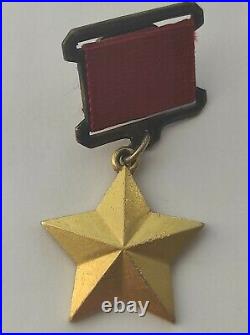

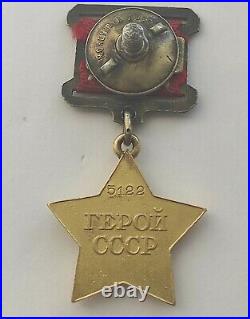
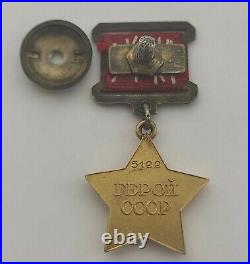
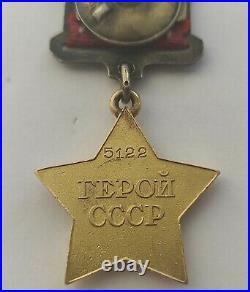
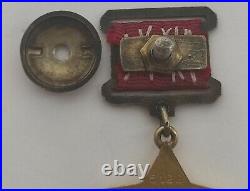
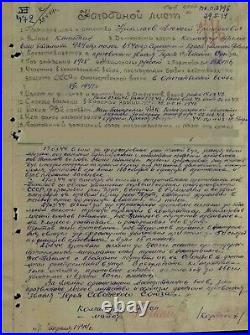

Good day to all. For those who are really interested I will send additional photos. Priority sales in Ukraine, you can meet in person in Kiev by prior arrangement. Medal “Gold Star” Title of Hero of the Soviet Union. The title of Hero of the Soviet Union (GSS) is the highest degree of distinction and is awarded for personal or collective services to the Soviet state and society associated with the accomplishment of a heroic deed. The Hero of the Soviet Union was awarded a badge of special distinction – the Gold Star medal. The medal is made of 950 gold. The medal pad is made of silver. Nikolaev Alexey Grigorievich – battalion commander of the 929th rifle regiment (254th rifle Cherkassk Red Banner division, 52nd army, 2nd Ukrainian front), captain. Born on February 12, 1915 in the village of Sharya, now Lyubytinsky District, Novgorod Region, into a peasant family. He graduated from the 7th grade of the Sharya school in 1928, courses of accountants at the station Budogoshch in August 1931. He worked as an accountant of the Budogoshchsky timber industry enterprise, a senior accountant of a rafting office in the village of Pchevzha, now in the Kirishsky district of the Leningrad region, a secretary of the Sharya village council of the Malovishersky district, an accountant-cashier of the Zelenchinsky timber station of the Malovishersky timber industry. From May 1937 to November 1940 he did active military service in the army. Member of the CPSU (b) / CPSU since 1939. He graduated from the school for junior commanders, the divisional party school at the 67th rifle division. Secretary of the Komsomol Bureau of the 56th Rifle Regiment of the 67th Rifle Division. After being transferred to the reserve, he worked as the head of the mobilization-secret department of the Malovishersky timber industry enterprise. Again called up by the Malovishersky district military enlistment office on July 3, 1941. During the Great Patriotic War in the active army – from July 1941. He fought on the Northern, Leningrad, Volkhov, and 2nd Ukrainian fronts. He graduated from the advanced training courses for command personnel (KUKS) at the 52nd Army of the 2nd Ukrainian Front in November 1943. He was wounded four times, including one seriously, shell-shocked. Particularly distinguished himself during the Uman-Botoshan offensive operation. On March 13, 1944, under heavy artillery and mortar fire from the enemy, at the head of his battalion, he was the first to cross the Southern Bug River and set up a bridgehead on the right bank for the development of a further offensive, destroying 120 enemy soldiers and officers and taking 20 prisoners. On March 27, 1944, with his battalion, he first crossed the state border of the USSR, crossed the Prut River, entered the territory of Romania and seized a bridgehead on the right bank, which he held for 24 hours until the main forces of the regiment arrived. On March 29, 1944, in a battle for the village of Fransoulins, he repelled three enemy counterattacks and captured the village, destroying up to 150 soldiers and officers and capturing 15 prisoners. Kazom of the Presidium of the Supreme Soviet of the USSR on September 13, 1944 for exemplary performance of combat missions of the command on the front against the German invaders and the courage and heroism shown at the same time. Was awarded the title of Hero of the Soviet Union with the award of the Order of Lenin and the Gold Star medal. From December 1944 he served in the Kharkov Military District as commander of a separate training battalion of the 6th reserve rifle division, from December 1945 – commander of a separate training battalion of the 288th rifle division. Since June 1946 Major A. Nikolaev is in reserve. He lived in the town of Malaya Vishera. From June 1946 to September 1947 he worked as chairman of the city Council of Working People’s Deputies. Graduated from the Leningrad two-year interregional party school in August 1949. From August 1949 to April 1954 he worked as chairman of the executive committee of the Malovishersky District Council of Working People’s Deputies, from April 1954 to February 1957 – chairman of the board of the Novaya Zhizn collective farm in the Sharya village of the Malovishersky District. On December 17, 1950, he was elected a deputy of the Novgorod Regional Council of Working People’s Deputies in the Malovishersky rural constituency No. He worked as a forest foreman at the Sharya timber station of the Dregelsky timber industry enterprise. Died June 1, 1982. Buried in the village of Sharya, Lyubytinsky district. He was awarded the Orders of Lenin (09/13/1944), Alexander Nevsky (07/29/1944), Red Star (01/15/1944), medals. From July 1941 to February 1942, P. Nikolaev, as a political instructor of a company of a separate sapper battalion of the 23rd Army, fought on the Northern (from August 23, 1941 – Leningrad) front. Participated in defensive battles on the Karelian Isthmus, where the 23rd Army covered Leningrad from the north, under pressure from superior enemy forces was forced to leave Vyborg by September 1, 1941 and retreat to the 1939 border. In the future, she steadfastly held the lines on this border. From February 1942 he fought in Leningrad, and from July 1942 on the Volkhov front as commissar of the rifle battalion of the 857th rifle regiment of the 294th rifle division, from December 1942 to May 1943 – deputy commander of a separate training battalion of the 294th rifle divisions. The division in February – March 1942 was part of the 8th Army, later – as part of the 54th Army. He took part in the Luban offensive operation (January 7 – April 30, 1942) – an attempt to unblock Leningrad, during which the 54th Army struck from the Pogostye area to the southwest, in the direction of Tosno. The operation was not crowned with success, the Soviet troops suffered heavy losses, the 2nd Shock Army of General Vlasov was surrounded and defeated. During this operation, A. Nikolaev was wounded on March 14, 1942. In subsequent battles on the Volkhov front, he was wounded twice more in 1942 – on June 23 and September 5. In 1943, as part of the 54th Army, he took part in the offensive on February 10-27 during Operation Polar Star, which was also unsuccessful and fraught with heavy losses suffered by the army and the 294th Infantry Division. In May 1943, the division was withdrawn to the reserve of the Headquarters of the Supreme High Command and included in the 52nd Army. Nikolaev was sent to the advanced training courses for command personnel (KUKS) at the 52nd Army. During his studies at the courses, the army from the reserve in August 1943 was redeployed to Voronezh, and in November 1943 to the 2nd Ukrainian Front. In November 1943, Captain A. Nikolaev, who graduated from KUKS, was appointed commander of the rifle battalion of the 933rd rifle regiment of the 254th rifle division of the 52nd army. Participated in the Znamenskaya offensive operation (November 20 – December 23, 1943) – an integral part of the Nizhnedneprovsk strategic operation, including the liberation of the city of Cherkassy (Ukraine); Uman-Botoshan offensive operation (March 5 – April 17, 1944); Iasi-Kishinev strategic offensive operation (20 – 29 August 1944). During the Znamenskaya operation, the 52nd Army, located on a small Dnieper bridgehead near the city of Cherkassy, away from the main strike grouping of the front, fought to expand the bridgehead and capture the city of Cherkassy, which the enemy had turned into a powerful defensive hub. After stubborn battles, the city was liberated on December 14, 1944 with the participation of the 254th Infantry Division, which was awarded the title of Cherkassy. Nikolaev in the battles for the city of Cherkassy from 1 to 14 December 1943 showed himself to be a staunch and courageous officer. On December 9, in the city of Cherkassy, he was in the battle formations of the battalion and inspired the soldiers by personal example. The enemy threw infantry into the attack with the support of 12 tanks. Thanks to the courage and resilience of Captain Nikolaev, the attack was repulsed. The battalion knocked out 2 tanks, destroyed 3 machine guns, two 81-mm mortars, 1 armored vehicle. Captain Nikolaev, repelling the attack, moved forward and cleared 4 city blocks from the enemy. I personally destroyed 11 enemy soldiers. He was awarded the Order of the Red Star. On December 16, 1944, in the area of the city of Cherkassy, A. Nikolaev was wounded for the fourth time. After recovery, he was appointed battalion commander of the 929th Infantry Regiment of the same 254th Infantry Division. Particularly distinguished himself during the Uman-Botoshan operation, where on March 26, 1944 he was wounded. From the award list for conferring the title of Hero of the Soviet Union. 03/13/1944 in the battle for the crossing of the Southern Bug River, risking his life, under heavy artillery and mortar fire from the enemy comrade. Nikolaev, at the head of his battalion, was the first to cross the Southern Bug River and created a bridgehead on the right bank for the development of a further offensive, destroying 120 enemy soldiers and officers and taking 20 prisoners. 03/27/1944, despite strong enemy resistance, Comrade. Nikolaev with his battalion was the first to cross the state border of the USSR, crossed the Prut River, entered Romania and created a bridgehead on the right bank of the Prut River, which he held for 24 hours until the main forces of the regiment arrived. 03/29/1944, in the battle for the village of Fransuleni, the enemy, up to an infantry battalion, went over to a counterattack three times. Having mobilized the personnel of the battalion, Comrade. Nikolaev allowed the enemy to approach the enemy at close range and shot him point-blank. Having exhausted the forces of the enemy, Comrade. Nikolaev went on the offensive and captured the village of Fransulene, destroying up to 150 soldiers and officers, and took 15 prisoners. On 04/02/1944, the enemy with up to 400 people, supported by artillery and mortar fire, went on the offensive. Comrade Nikolaev with 11 fighters let them go 60 meters, and then began to shoot at point-blank range. As a result, the enemy’s counterattack was repulsed, the enemy left up to 250 people on the battlefield killed, and 20 people were taken prisoner. For the skillful organization of offensive battles, for the shown personal courage and heroism, he deserves the title of Hero of the Soviet Union. Commander of the 929th Infantry Regiment, Major Korotkikh. After the completion of the Uman-Botoshan operation, the 254th Infantry Division, as part of the 52nd Army, fought on the territory of Romania in the area north of the city of Iasi. The commander of the 2nd battalion of the 929th rifle regiment, Captain A. Nikolaev, in battles from May 30 to June 10, 1944, at altitudes 13 km north of the city of Yassy, skillfully led the battalion’s combat operations. On May 30, 1944, when enemy tanks reached the rear of the 2nd battalion, a real threat was created to encircle the battalion. Comrade Nikolaev, being in battle formations, organized a rebuff to tanks and cut off the infantry. 2 tanks were knocked out, the enemy infantry was cut off from the tanks and came under a hurricane of rifle and machine gun fire from the battalion. On June 2, 1944, the battalion repelled 5 enemy counterattacks in a day, took prisoners and trophies, including 14 machine guns. The enemy left no less than 150 people killed on the battlefield. June 5, 1944, being cut off by German machine gunners from the battalion units, captain. Nikolaev organized staff workers, defeated the leaked submachine gunners, took prisoners and trophies. He was awarded the Order of Alexander Nevsky. After the completion of the Jassy-Kishinev offensive operation in early September 1944, the 254th Infantry Division was withdrawn from the fighting, redeployed first to the territory of the Volyn region of Ukraine, and at the end of October 1944, having made a march through the territory of the liberated part of Poland, concentrated south of the city of Nisko in 40 kilometers east of Sandomierz. She stayed here until the end of December 1944, after which she crossed the Vistula River to the Sandomierz bridgehead. From December 1944 A. Nikolaev served in the Kharkov military district. Thank you for stopping by my store! I value your feedback and opinion. If you have any kind of question, please do not hesitate to reach me out. Besides, I always have special discounts for my buyers, just get in touch and we can discuss your conditions. Thank you once again. The item “Medal Gold Star Hero of the Soviet Union” is in sale since Sunday, November 15, 2020. This item is in the category “Collectibles\Militaria\WW II (1939-45)\Original Period Items\Russia\Medals, Pins & Ribbons”. The seller is “vovvorobe_4″ and is located in Ingylec. This item can be shipped worldwide.

